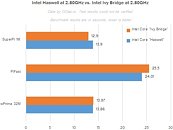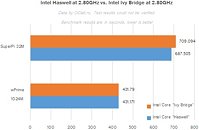Friday, February 1st 2013

Intel "Haswell" Quad-Core CPU Benchmarked, Compared Clock-for-Clock with "Ivy Bridge"
Russian tech publication OCLab.ru, which claims access to Intel's next-generation Core "Haswell" processor engineering-sample (and an LGA1150 8-series motherboard!), wasted no time in running a quick clock-for-clock performance comparison with the current Core "Ivy Bridge" processor. In its comparison, it set both chips to run at a fixed 2.80 GHz clock speed (by disabling Turbo Boost, C1E, and EIST), indicating that the ES OCLab is in possession of doesn't go beyond that frequency.
The two chips were put through SuperPi 1M, PiFast, and wPrime 32M. The Core "Haswell" chip is only marginally faster than Ivy Bridge, in fact slower in one test. In its next battery of tests, the reviewer stepped up iterations (load), putting the chips through single-threaded SuperPi 32M, and multi-threaded wPrime 1024M. While wPrime performance is nearly identical between the two chips, Haswell crunched SuperPi 32M about 3 percent quicker than Ivy Bridge. It's still to early to take a call on CPU performance percentage difference between the two architectures. Intel's Core "Haswell" processors launch in the first week of June.
Source:
OCLab.ru
The two chips were put through SuperPi 1M, PiFast, and wPrime 32M. The Core "Haswell" chip is only marginally faster than Ivy Bridge, in fact slower in one test. In its next battery of tests, the reviewer stepped up iterations (load), putting the chips through single-threaded SuperPi 32M, and multi-threaded wPrime 1024M. While wPrime performance is nearly identical between the two chips, Haswell crunched SuperPi 32M about 3 percent quicker than Ivy Bridge. It's still to early to take a call on CPU performance percentage difference between the two architectures. Intel's Core "Haswell" processors launch in the first week of June.


118 Comments on Intel "Haswell" Quad-Core CPU Benchmarked, Compared Clock-for-Clock with "Ivy Bridge"
I don't really think Haswell be be all that bad, but it strikes me as odd that they'd go back to Nehalem clock domain design for Haswell, unless they want OC to be more interesting. The only reason they'd invest that effort, and further complicate the chip, to me, is because clock-for-clock, Haswell is a bit worse off.
Many parts of internal cache has been doubled, L3 is changed too, lots of other changes...Haswell should be good...better than IVB...but for me it is too early to even guess what those improvements will bring. I'd be happy with exact same performance, faster ram clocks(to help cache subsystem), and lower power draw. IVB is pretty damn fast as is.
That's not really what I call lower power consumption. Or does Intel only mean the mobile ones?
Kinda weird. :confused:
Power Consumption be damned when I don't get to use my desktop half the year.
All things considered though, if Haswell lowers power consumption even further I might be in the market for a new laptop after Haswell mobile CPUs start becoming mainstream.
A 4770S will be perfect for a modern HTPC that I plan on building for my HDTV in the near future.
haswell on the other hand if i intel isnt bluffing is supposed to have a much wider range of operating voltage, that doesnt only mean lower tdp like some understood it, but also higher tdp for the higher voltage models, that means higher stable clocks without running into problemsso are you suggesting ivy bridge has really bad performance scaling with clockspeed? :P well this is exactly why haswell took the other approach, so no its a fair comparison, as fair as it can get actually because not every ivy bridge chip is sold at 3.4ghz clockspeedi second what i said earlier, there is a reason the highest quad core ivy is rated at 77watt and not 95watt like sandy, its because clocking it accordingly to the 95watt envelope will pretty much get it near its limit and run into binning and stability problems for comfort, not to mention dissapointment for overclockers(who already saw no benefit from moving from sandy) because of a cpu clocked near its limit, haswell is supposed to address that issue
431s for wprime 1024m ... Darn thats slow.
I can do it in ~30s
Guess my 4.0GHz i7-930 will stick around for whatever comes after Haswell.
An unfair comparison but my amd rig creams that score...
hwbot.org/submission/2346765_